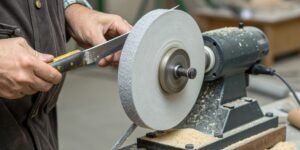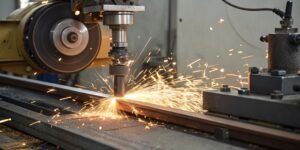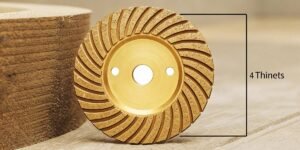
What does an angle grinder do that other tools can't?
Struggling with tools for multiple tasks? Carrying a heavy toolbox is inefficient. An angle grinder replaces many tools, saving you time and effort on the job site.
An angle grinder offers unmatched versatility. It can cut, grind, polish, and deburr various materials like metal and stone. This multi-functionality in a single handheld tool is its unique advantage, making it a cornerstone for professionals in many industries.

Over my nearly three decades in this industry, I’ve seen many tools. Our factory is located in Henan, the heart of China’s abrasives production. Competition here is intense. It has taught us that only the most useful and reliable tools stand the test of time. The angle grinder1 is one of those tools. Its true value is clear when you see what it does that other tools cannot. Let’s look closer at why this tool is so special. It has earned a permanent place in any professional’s toolkit.
How does an angle grinder differ from a traditional power saw?
Need to cut metal fast but your saw is too slow? Power saws are great for wood but struggle with harder materials. An angle grinder cuts through metal effortlessly.
A power saw, like a circular saw, uses a toothed blade for precise, straight cuts, mainly in wood. An angle grinder uses an abrasive disc that grinds material away. This makes it far more versatile for hard materials like metal, stone, and concrete, offering flexibility over precision.

The fundamental difference lies in how they remove material. A power saw2 uses teeth to rip or tear fibers apart. This is very effective for softer materials like wood or plastic. An angle grinder works by abrasion3. The disc is covered in hard particles that grind away at the material. This method works on almost any material, especially very hard ones.
I remember a customer from Germany who manufactures custom steel frames. He was using a metal-cutting circular saw. The expensive saw blades dulled quickly, and the cuts were not clean. He was frustrated with the high costs and slow progress. We sent him samples of our RL brand thin cutting discs for his angle grinders. He found he could cut through steel bars much faster. The discs were also much cheaper to replace than large saw blades. This simple change completely transformed his workflow, improving both speed and cost-effectiveness.
Key Differences: Grinder vs. Saw
| Feature | Angle Grinder | Power Saw (e.g., Circular Saw) |
|---|---|---|
| Mechanism | Abrasion (grinds material) | Ripping/Tearing (with teeth) |
| Primary Use | Cutting, grinding, polishing, deburring | Straight-line cutting |
| Best Materials | Metal, stone, concrete, tile | Wood, plastic, soft metals |
| Cut Type | Rough cuts, flush cuts, shaping | Precise, straight, clean cuts |
| Versatility | Extremely high with disc changes | Low; specific to material/cut type |
What unique functions does an angle grinder have compared to other grinding tools?
Have a bench grinder for sharpening and a sander for finishing? Switching between tools wastes time. An angle grinder combines these functions and more into one portable device.
Unlike stationary bench grinders or specialized sanders, an angle grinder is portable and adaptable. Its unique strength comes from the wide variety of attachments available. These accessories allow it to perform aggressive material removal, fine polishing, rust stripping, and sharpening, all with a single tool.

Other grinding tools are often specialized. A bench grinder is bolted to a workbench. It is excellent for sharpening drill bits or shaping small metal parts you can hold. An orbital sander is perfect for creating a smooth finish on a flat wooden surface. But you cannot take a bench grinder to a construction site to work on installed steel beams. You also cannot use an orbital sander to remove a thick weld bead. The angle grinder does both.
Its portability means you take the tool to the work, not the work to the tool. Its power allows for aggressive stock removal with a grinding wheel or a flap disc. Then, you can switch to a polishing4 pad for a fine finish. We had a client in the ship repair industry who used large belt sanders for rust and bench grinders in their workshop. They switched to our angle grinders with RL brand wire wheels and flap discs. Their teams could work directly on the curved ship hulls, removing rust and preparing surfaces for painting much more efficiently. It reduced their repair times significantly.
Grinding Tool Function Comparison
| Tool | Portability | Primary Function(s) | Key Advantage |
|---|---|---|---|
| Angle Grinder | High | Cutting, grinding, polishing, rust removal | Versatility and power in one tool |
| Bench Grinder | None (Stationary) | Sharpening tools, shaping small parts | Stability and precision for small items |
| Orbital Sander | High | Fine surface finishing | Smooth, swirl-free finish |
What tasks can only be accomplished with an angle grinder?
Facing a tight corner or an awkward angle? Other tools just can’t reach. An angle grinder’s design lets you work in confined spaces where nothing else fits.
Specific tasks are almost impossible without an angle grinder. These include flush-cutting bolts against a surface, cleaning welds in tight joints, cutting intricate shapes in tile, and removing mortar from between bricks. Its unique blend of power, control, and form factor is unmatched.

The true indispensability of an angle grinder shines in specific, challenging applications where no other tool geometry will work. Its right-angle head design is the key. It allows the face of the abrasive disc to be presented flat against a surface, or the edge to be used for cutting in tight spaces.
Here are a few tasks where the angle grinder is the only real option:
1. Flush Cutting
Imagine a steel bolt sticking out of a concrete floor. You need it gone, perfectly level with the surface. A saw would leave a small piece sticking up. An angle grinder with a cutting disc can cut that bolt completely flush.
2. Weld Preparation and Cleaning
When welding two pieces of pipe at an angle, you need to create a V-groove for a strong joint. A grinder is used to shape this groove. After welding, the same tool with a grinding or flap disc is used to smooth the weld bead.
3. Tuckpointing
Removing old, crumbling mortar from between bricks is a job called tuckpointing5. An angle grinder fitted with a thick diamond blade is the standard tool. It is the only practical way to clear out the old mortar without damaging the bricks.
A construction partner in North America was building a high-rise and faced this exact flush-cutting6 problem. They had thousands of anchor bolts to trim. Saws left nubs, which was unacceptable. An angle grinder equipped with our RL cutting discs was the only tool that gave them a perfectly flat finish, saving countless hours and ensuring a quality result.
Conclusion
In short, an angle grinder is a must-have tool. Its unique ability to cut, grind, and finish diverse materials in almost any location makes it truly indispensable for professional work.
-
Explore the versatility and efficiency of angle grinders, which can replace multiple tools and save you time on the job. ↩
-
Learn the key differences between angle grinders and power saws, highlighting the advantages of each. ↩
-
Understand how the abrasive action of angle grinders contributes to their effectiveness in various tasks. ↩
-
Find out how angle grinders can achieve a fine polish on different surfaces, adding to their versatility. ↩
-
Discover how angle grinders are essential for tuckpointing, making the process efficient and effective. ↩
-
Learn about the flush-cutting technique and how angle grinders excel in achieving perfect finishes. ↩
Written by
leeon
You may also be interested in:

How to use a hard felt bench grinding wheel on knives?
Getting a razor-sharp, polished edge on a knife can be frustrating and slow. A dull knife is dangerous, and using the wrong tool can easily

What are grinding cracks and how do you stop them?
Are tiny cracks appearing on your ground surfaces? This problem leads to part failure, wasting time and money. You can solve it by understanding the

How to reduce the cycle time in a grinding machine?
Is your grinding process a major bottleneck? Slow cycle times hurt your bottom line and delay deliveries. You can speed up production by optimizing key

Do you regularly sharpen your chisels? If so, how?
A dull chisel ruins wood and causes frustration. This wastes time and expensive materials. Learning to sharpen correctly is the simple, game-changing solution you need

Which material is used in making cutting wheel?
Have you ever used a cutting wheel that wore out too fast or just wouldn’t cut? The right material is key to solving this problem

How is a grinding wheel specified?
Confused by the codes on a grinding wheel? Making the wrong choice costs money and ruins parts. Let me show you how to read them
